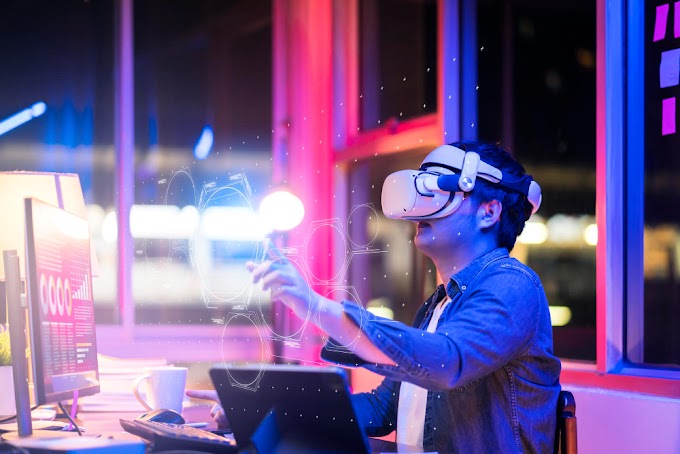Introduction: AR & VR are not just a digital content.
Augmented Reality (AR) and Virtual Reality (VR) are two innovative technologies that are transforming the way we interact with digital content. In this blog, we'll explore the differences between AR and VR, their applications, where to find them, and their benefits.
Hey folks Just click below to get specific info you need.
What is Augmented Reality?
AR is a technology that combines digital information with the real world. It overlays digital information onto the user's view of the physical world, using specialized hardware and software. AR is commonly used in mobile apps for shopping, education, and more.
What is Virtual Reality?
VR is a technology that creates a completely digital environment that users can interact with. It immerses the user in a simulated world using specialized hardware such as VR headsets. VR can be used for gaming, education, training, and more.
Applications of AR and VR:
AR and VR have found applications in various industries, such as gaming, education, and medicine. In education, AR and VR can be used to create interactive and engaging content that enhances learning. In the medical industry, VR can simulate surgeries and provide doctors with safe and controlled training.
Applications of Augmented Reality (AR):
- Retail and E-commerce:
- Enhance in-store experiences and offer virtual try-on for products.
- Education:
- Bring learning to life with interactive and immersive experiences.
- Healthcare:
- Assist medical professionals with visualization and training.
- Marketing and Advertising:
- Create interactive campaigns and engaging experiences for customers.
*Free vector industrial augmented reality isometric flowchart*
Applications of Virtual Reality (VR):
- Gaming:
- Create fully immersive gaming experiences.
- Education and Training:
- Simulate real-life scenarios for training purposes.
- Entertainment:
- Provide immersive experiences for movies and concerts.
- Real Estate and Architecture:
- Offer virtual tours of properties and simulate building designs.
A table summarizing the applications of AR & VR
| Application | Augmented Reality (AR) | Virtual Reality (VR) |
|---|---|---|
| Retail and E-commerce | Enhance in-store experiences and offer virtual try-on for products | N/A |
| Education | Bring learning to life with interactive and immersive experiences | Simulate real-life scenarios for training purposes |
| Healthcare | Assist medical professionals with visualization and training | N/A |
| Marketing and Advertising | Create interactive campaigns and engaging experiences for customers | N/A |
| Gaming | N/A | Create fully immersive gaming experiences |
| Entertainment | N/A | Provide immersive experiences for movies and concerts |
| Real Estate and Architecture | Offer virtual tours of properties and simulate building designs | N/A |
AR applications are widely available on both iOS and Android devices, and they can be downloaded from app stores. VR devices range from mobile-based headsets to high-end devices such as the Oculus Rift and HTC Vive.
AR & VR Benefits
| Benefits | Augmented Reality (AR) | Virtual Reality (VR) |
|---|---|---|
| Enhanced engagement | Yes | Yes |
| Increased efficiency | Yes | Yes |
| Improved safety | Yes | Yes |
| Personalization | Yes | No |
| Marketing and sales benefits | Yes | No |
| Enhanced immersion | No | Yes |
| Safe training | No | Yes |
| Reduced costs | No | Yes |
| Improved accessibility | No | Yes |
AR and VR in Healthcare:
AR and VR are being used in healthcare for various purposes, including training medical professionals and providing immersive therapy experiences. AR and VR can simulate medical procedures and environments, providing a safe and controlled learning environment for medical professionals.
* Click here to enter AR Hospitals.
Enhancing the YouTube Experience with AR and VR: A New Era of Immersive Content
Not all users of YouTube may be aware of the AR and VR features that are available on the platform. Here is some information on how YouTube is using these technologies to enhance the user experience:
- VR videos: YouTube offers VR videos that can be viewed on a VR headset or with a smartphone using a cardboard viewer. These videos provide a fully immersive experience where users can feel like they are actually in the video.
- AR filters: YouTube has also introduced AR filters for its mobile app, allowing users to add virtual effects and animations to their videos in real-time. These filters use AR technology to detect the user's face and track their movements, creating a fun and interactive experience
- 360-degree videos: YouTube also supports 360-degree videos that allow users to explore a video by dragging the cursor around to see different angles. This feature can be used to provide a more immersive experience, especially for travel, music, and sports videos
- Live streaming: YouTube also supports live streaming in VR, allowing users to experience live events in a fully immersive way. This feature has been used for live concerts, sporting events, and even political debates.
While not all users may be aware of these features, they are available for those who want to explore and try them out - Click here for "How to Access the Virtual Reality in Youtube videos and live streams."
Conclusion:
As AR and VR continue to evolve, we can expect to see even more innovative applications and benefits in the future. Understanding the differences between these technologies and their capabilities can help us make the most of their potential.
Overall, We aims to inform readers about the potential of AR and VR technologies and how they are transforming various industries.
Thank You . - Ftechbros.










